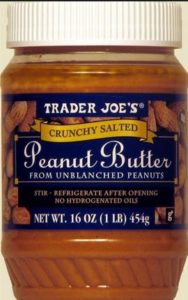 Dan wonders how you can tell whether peanut butter was made with the peanut skins–that papery reddish stuff that surrounds each nut. As Dan points out, these skins are quite rich in phenolic compounds (fancy antioxidants) and peanut butter made with the skins is a lot more nutritious.
Dan wonders how you can tell whether peanut butter was made with the peanut skins–that papery reddish stuff that surrounds each nut. As Dan points out, these skins are quite rich in phenolic compounds (fancy antioxidants) and peanut butter made with the skins is a lot more nutritious.
Unfortunately, the vast majority of peanut butter producers remove the skins before grinding the nuts. But there are a few exceptions. Trader Joe’s has one, as does Nature’s Promise (the organic brand for Giant Food Stores.) I’m sure there are others.
One tip-off is the color. Peanut butter made with the skins is darker brown than that made without. If the ingredient list shows “unblanched peanuts,” you have hit the jackpot!
You can also make your own peanut butter using unskinned peanuts at home with a food processor or with one of those in-store grinders.
Thanks for that great question, Dan! I will definitely seek out unblanched peanut butter next time I shop.

What is the comparative sodium content between peanut butter made with unblanched peanuts as opposed to peanut butter made from blanched peanuts? Please give exact amount differences.
The skins themselves would not add a significant amount of sodium, but salt may be added to the product. The Nutrition Facts label would be the best source for “exact amounts” of sodium in a specific product.